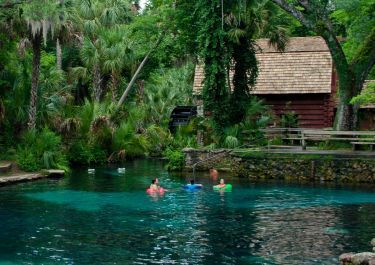
Juniper Springs

Juniper Springs is one of the oldest and best-known recreation areas on the East Coast. Located between Ocala and Ormond Beach along SR 40, this complex of swimming and picnic area, campground and trails was constructed in the 1930s by the Civilian Conservation Corps. This setting houses hundreds of tiny bubbling springs and massive springs gushing out of crevices in the earth beneath a dense canopy of palms and oaks, an oasis within the heart of the desert-like scrub ecosystem.
Boating
Juniper Run is a narrow, winding waterway set under a dense canopy of old-growth forest and few places solid enough to get out of your canoe. Just before the take out point near SR 19, the waterway broadens to encompass wetlands teeming with wading birds and wildlife.
Camping
Who doesn't love camping under a dense canopy of live oaks? Juniper Springs is one of the nation's top destinations for camping, not just because of the many activities available on site but also for its well-shaded setting.
Day Hiking / Walking / Backpacking
In addition to day hiking on the Florida Trail, which passes through the recreation area, families and those with limited mobility will especially appreciate the Juniper Run Nature Trail. This short (0.8 mile round-trip) but delightful introduction to the subtropical habitats found along our spring runs includes viewing areas to watch the bubbling springs; thickets of needle palms; tall sweetgum, maple and pine trees; and a variety of wildlife, from otters to our unique albino gray squirrels.
Backpackers often use Juniper Springs as a stopping-off point while working their way along a 72-mile unbroken segment of the Florida Trail.
Interpretive Area
As a Civilian Conservation Corps-era recreation area and campground, Juniper Springs is a historic site with an interesting story to tell. Stop in the old Mill House to learn why and how the swimming area and campground were built, and how the mill used to provide electricity for the campground.
Nature Watching
The dense, jungle-like forests surrounding Juniper Springs and Juniper Run - as well as the waterway itself - are home to wildlife that you might not commonly see elsewhere. Among the more interesting residents of our natural communities are the albino gray squirrels seen near the Mill House, the otters that play along the edges of the spring run and the American eels that migrate out to the Sargasso Sea to spawn, returning to Juniper Springs to live.
Swimming
Juniper Springs is notable as a crystalline pool of spring outflow, shallow at one end and deep enough to jump into at the other. Natural tapegrass grows along the bottom of the spring. Don't be surprised to see an American eel amid the greenery.





























